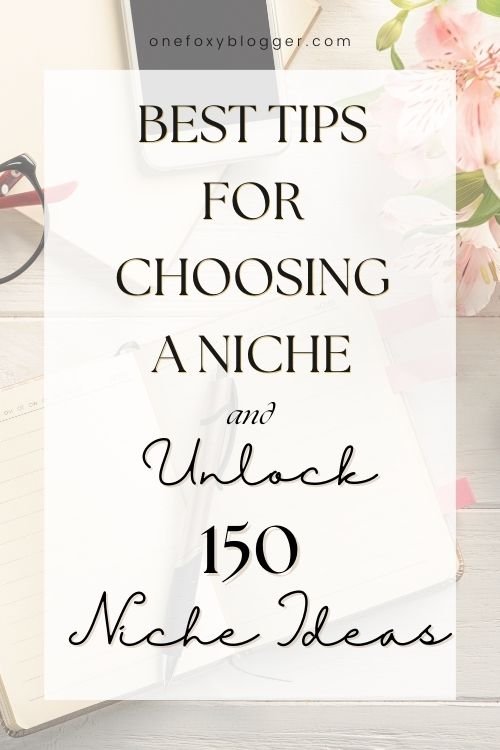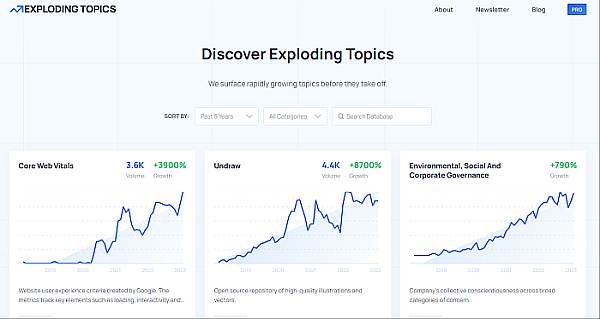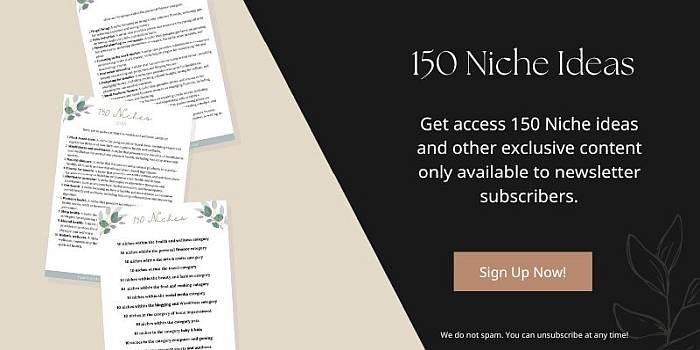Best tips for Choosing a Niche: Unlock 150 profitable niche ideas
So, you plan to start a blog but need help figuring out where to start? Well, one of the most important things you’ll need to do is choose a niche. You can define a niche as a specific area of interest on which your blog will focus. And why is it so important to have a niche? Well, there are a few reasons.
This post may contain affiliate links. This means I get a commission if you purchase through my links at no cost to you. Read the full disclosure here.

Firstly, having a niche helps you stand out in a crowded market. There are millions of blogs out there, covering everything from cooking to politics to fashion. By choosing a niche, you’re carving out a specific area of expertise and making it easier for people to find you.
Finally, having a niche makes it easier to monetize your blog. When you have a specific area of expertise, it’s easier to attract a loyal audience interested in your content. When you have an engaged audience, making money through affiliate marketing, sponsored content, and selling your products or services is easier.
As you can see, finding a niche for your blog is crucial to stand out, creating great content, and making money. Where do you start when it comes to finding the right niche for you?
Choosing a blog niche can be tricky, but you can find the perfect fit with careful consideration and planning. Below, I am sharing some tips for selecting the best niche for your blog.
1. Consider your passions and interests.
A question commonly asked; How do I find my niche? The first step in choosing a niche for your blog is considering your interests and passions. You will likely devote a lot of time to blogging, so you will want to select a topic you’re passionate about and will be happy to write about for years to come.
Here are some tips to help you identify your passions for choosing a niche:
#1. Start with what you love
Think about your hobbies, interests, and things you enjoy doing in your free time. What are you passionate about? It could be anything from cooking to hiking to gaming. Make a list of your top interests and see if there’s a way to turn them into a niche.
#2. Consider your skills and expertise.
What are you good at? What have you learned through your education or career? You might have a particular skill or expertise that could be turned into a niche. For example, if you’re a graphic designer, you could create a blog or business focused on design tips and tutorials.
#3. Look for gaps in the market.
Take a look at existing blogs or businesses in your areas of interest. Are there any gaps in the market? Is there a topic or angle that still needs to be covered? Finding an underserved niche can be a great way to stand out and attract an audience.
#4. Think about your values.
What are your values and beliefs? Is there a cause or issue that you’re passionate about? For example, you could create a blog or business promoting social or environmental justice.
#5. Experiment and explore
Don’t be afraid to try different niches and see what feels right for you. You could start by writing a few blog posts or creating a social media account focused on a particular topic. See how it feels and if an audience responds to your writing.
[wpcode id=”29997″]
2. Evaluate the market demand
#1. Use Google Trends
You can use Google Trends to see how often certain keywords or topics are searched for on Google. Using Google Trends, you can see the interest in the topic you’re considering. You can also see how interest in the topic has changed over time, which can help you measure its long-term potential. With the site Exploding Topics, you can find trend keywords and topics that are popular in a variety of categories.

#2. Look at keyword research.
Keyword research is another way to get a sense of interest in a certain topic. Tools like Google’s Keyword Planner or SEMrush can help you identify popular keywords related to your niche and show how many people search for them monthly. It’ll help you figure out the potential audience for your blog or business.
#3. Check out social media.
When choosing a niche, social media can also be a great way to estimate interest in a certain topic. Look for relevant hashtags or groups related to your niche on platforms like Instagram, Twitter, and Facebook. This can help you see how many people are talking about the topic and what content they’re interested in. With a Pinterest business account, you can access Pinterest predictions to see the top emerging trends of the year ahead.
💕 Read also: 17 Best blogging tips for beginners to jumpstart your blogging career
3. Identify your target audience
To build a successful blog, it’s important to clearly understand your target audience. Who are you writing for? What are their interests and needs? If you know your target audience, you can tailor your content to their interests and needs.
You can find your target audience by doing these things:
#1. Define your niche
The first step in finding your target audience is to define your niche. What is your blog or business about? Who are you trying to reach? By specifying your niche, you can narrow down who your target audience might be.
#2. Create customer personas
Creating customer personas is a helpful way to visualize and understand your target audience. It is a fictional representation of the customer you want to attract. To create a customer persona, think about the demographic and psychographic characteristics of your ideal reader or customer, such as their age, gender, interests, and values.
#3. Conduct market research
Market research can help you gather data about your potential audience. This can include conducting surveys, analyzing social media trends, or looking at industry reports. By collecting data, you can better understand who your target audience is and what they’re interested in.
[wpcode id=”29997″]
#4. Use analytics tools
Analytics tools like Google Analytics or social media insights can provide valuable data about your audience. You can use this data to understand the demographics of your current audience, what content they’re engaging with, and how they’re finding your blog or business.
#5. Engage with your audience
Finally, engaging with your audience is a great way to learn more about them. Respond to comments and messages, ask for feedback, and create opportunities for two-way communication. This can help you build relationships with your audience to better understand their needs.
Using these tips, you can build a picture of your target audience and create content or products that resonate with them. Remember that your target audience might change over time, so it’s important to keep researching and engaging with them to stay connected.
4. Check out the competition.
Before you finalize your niche, take some time to research your competition. Are there other blogs in your niche that are already established and successful? Do they have a lot of followers or customers?
This can give you a sense of the level of competition in your niche and whether or not there’s room for another player. If so, can you differentiate yourself and offer something unique? If not, it may indicate that your niche is too narrow or saturated.
How can you tell if a niche is competitive?
One of the easiest ways is to utilize tools like Semrush or Ahrefs. Find the broadest keywords within a niche and examine the keyword difficulty score, cost per click, and amount of searches. The keyword difficulty demonstrates factors that indicate how difficult it is to rank for that particular term.
Researching the market for a specific niche takes some time and effort, but by using these tips, you can get a better sense of whether or not your niche has the potential to be successful.
From the expert: tips for finding your niche
Here are some insightful tips for choosing a niche for your blog from Neil Patel, a well-known entrepreneur, marketer, and blogger.
In a Q&A session on YouTube, Neil Patel and Adam discuss how to find a profitable niche for a blog. Patel suggests that choosing a niche is not only about finding something one is passionate about in the short and long run. He advises finding a niche one is willing to work on for the next 10 to 20 years.
Patel emphasizes that passion is necessary, but a topic must also make money and have volume. He suggests using Google Keyword Planner, Ubersuggest, and Google Trends to find profitable niches with high traffic and cost-per-click rates. He also notes that having a niche website that is super authoritative and thorough on one topic is more effective than covering everything under the sun.
Related reading:
- Make Money Blogging: 11 Ideas for Monetizing Your Passion
- How to start a blog with WordPress using this comprehensive tutorial
- How to use Canva to create amazing designs for your blog
Niche market examples
What are the top niches to make money online? Below are some examples of niches with possibilities for making money.
- HEALTH AND WELLNESS: This niche includes fitness, nutrition, and mental health topics. With a growing interest in self-care and healthy living, there’s a lot of potential for monetization through products like workout plans, meal plans, and health supplements.
- PERSONAL FINANCE: Personal finance is a popular niche that includes topics like budgeting, investing, and saving money. As the cost of living rises and the need for financial literacy increases, there’s a large audience looking for advice and guidance in this area.
- BEAUTY AND FASHION: The beauty and fashion niche includes topics like makeup, skincare, and clothing. This highly visual niche lends itself well to monetization through affiliate marketing, sponsored content, and product reviews.
- TRAVEL: The travel niche is popular, with many people looking for tips and inspiration for their next adventure. Monetization opportunities in this niche include sponsored travel, affiliate marketing for travel-related products, and selling travel guides or courses.
- FOOD AND COOKING: Choosing a niche in food and cooking includes topics like recipes, meal prep, and cooking techniques. With a large audience interested in healthy eating and home cooking, there’s a lot of potential for monetization through affiliate marketing and sponsored content.
💕 Read also: 10 Best WordPress food blog themes to start an eye-catching recipe site.
These are just a few examples of profitable niches, but many others are out there, depending on your interests and expertise. The key is choosing a niche you’re passionate about with a large enough audience to support monetization.
Get 150 blog niche ideas
Do you still feel stuck when it comes to finding your niche? Check out these 150 niche ideas.

Be flexible
Finally, remember that it’s okay to be flexible. As you start writing and building your blog, you may discover that your niche needs to evolve or expand. Don’t be afraid to make changes and adapt as necessary to keep your blog fresh and relevant.
Remember, the key to finding a niche that you’re passionate about is to be true to yourself. Choosing a niche for your blog or online business based on profitability or popularity alone isn’t enough. Instead, focus on something you truly love and can see yourself sticking with in the long term.
Get access to the Canva Creator Vault.
Join our mailing list and get instant access to the Canva Creator Vault — a growing library of FREE templates, cheatsheets, font pairings, planners, and more!


![Master the art of creating an ebook to sell online [read or miss out] 6 creating an ebook](https://onefoxyblogger.com/wp-content/uploads/2022/03/creating-an-ebook.jpg)


